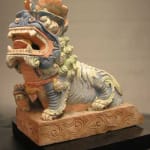Ming Dynasty Painted Female Lion, 1368 CE - 1644 CE
Terracotta
11.8 x 12.2
DL.1001
Further images
The Fu Lion, or Fu Dog as it is also known, is a ubiquitous symbol that has been employed repeatedly throughout the history of China. Sometimes referred to as the...
The Fu Lion, or Fu Dog as it is also known, is a ubiquitous symbol that has been employed repeatedly throughout the history of China. Sometimes referred to as the “Dog of Happiness” or the “Celestial Dog,” the earliest traces of the Fu Dog in China date to the Han Dynasty (206 B.C.-220 A.D.). Then it disappeared from Chinese art until it was resurrected during the cultural revival experienced during the Tang Dynasty (618-906 A.D.). While lions are not native to China, works of art with lion imagery from other civilizations were imported into China as gifts for the Emperor. The Fu Lion was brought into China with the arrival of Buddhism, where it became associated with the more familiar dog during assimilation. The lion is a sacred creature in the Buddhist pantheon and the Fu Lion was believed to be a companion of the Buddha.
While sculptures of Fu Lions originally stood guard outside Buddhist temples, by the time of the Ming Dynasty, when this work was created, the lions had lost most of their religious significance and were placed outside the entrances to homes and palaces out of custom. Even today, many monumental public buildings are decorated with lion figures standing guard at the base of the stairway. This female lion uses her front paw to trample a demon. This traditional gesture symbolizes the lion’s authority over evil spirits that might have tried to infiltrate the temple or palace. The delicate colouring, in tones of red, blue and yellow is particularly fine. The lion’s wide open mouth and protruding tongue have been expertly sculpted. The care lavished on this magnificent creation is also apparent in the swirling motifs, achieved through the use of incised lines, that decorate the plinth.
While sculptures of Fu Lions originally stood guard outside Buddhist temples, by the time of the Ming Dynasty, when this work was created, the lions had lost most of their religious significance and were placed outside the entrances to homes and palaces out of custom. Even today, many monumental public buildings are decorated with lion figures standing guard at the base of the stairway. This female lion uses her front paw to trample a demon. This traditional gesture symbolizes the lion’s authority over evil spirits that might have tried to infiltrate the temple or palace. The delicate colouring, in tones of red, blue and yellow is particularly fine. The lion’s wide open mouth and protruding tongue have been expertly sculpted. The care lavished on this magnificent creation is also apparent in the swirling motifs, achieved through the use of incised lines, that decorate the plinth.







